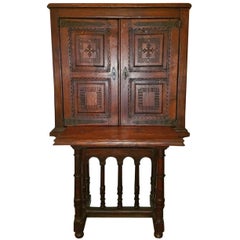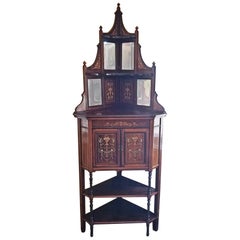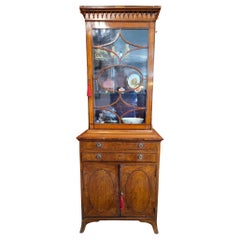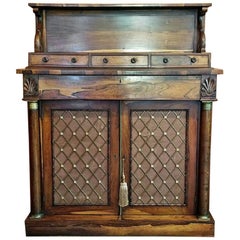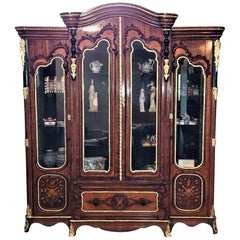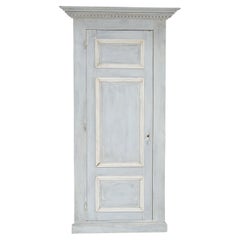Rockwell Antiques Cabinets
to
5
Height
to
Width
to
Depth
to
7
7
1
1
1
3
4
7
4
3
3
3
7
3
3
2
1
7
7
7
1
Carved Spanish Oak Writing Cabinet, Estate of Vincente Blasco Ibanez
Located in Dallas, TX
Presenting an absolutely stunning 16th century carved Spanish oak writing desk and cabinet, with amazing provenance and historical and literary significance.
This desk/cabinet was purchased by a wealthy Dallas family from a French antique auction held at the club room in the Stoneleigh court (hotel), Dallas on Wednesday the 2nd April 1930. (Now the meridian hotel). The auction was titled: “works of art and furnishings of the Chateau de Turique (Nancy) and the Conde-Rougemont home (Touraine). The cover of the catalog also has a seal of a coat of arms. The second page gives a brief description of the auction contents and states that " this exhibition will be presented by M. Fernand M. Adda of Paris France". The desk/cabinet was lot no: 565 and was described in the auction catalog as:
"Carved Spanish writing desk and cabinet...... 16th century period....Upper section a cabinet with two doors which are paneled and display a fine carving. The interior is fitted with eight engraved drawers, and a writing tablet is disclosed in the lower portion. Sustained and central arcade of columns. From Fontana Rosa collection. Supported on four turned legs with bulbous feet."
Fontana Rosa is a historic garden situated on the avenue Blasco Ibáñez in Menton, Alpes-Maritimes, on the French Riviera. The Spanish writer Vicente Blasco Ibanez (1869-1928) began to build it from 1922 on, and he set up home here with his second wife, Elena, and died there in 1928. Vicente Blasco Ibanez was a journalist, politician and best-selling Spanish novelist in various genres whose most widespread and lasting fame in the English-speaking world is from Hollywood films adapted from his works. The provenance is impeccable, it belonged to Ibanez and was part of his collection at Fontana Rosa when he died in 1928.
The auction in which it was first sold in Dallas was in 1930, which makes perfect sense from a 'timeline' point of view. Ibanez is a very important literary figure. Having regard to the fact that this is a writing desk means that in all probability, Ibanez would have 'penned' some of his famous works at this very desk and using the surviving slope/shelf.
Fontana Rosa is a historic garden situated on the Avenue Blasco Ibáñez in Menton, Alpes-Maritimes, on the French Riviera.
The Spanish writer Vicente Blasco Ibáñez (1869-1928) began to build it from 1922 on, and he set up home here with his second wife, Elena, and died there in 1928.
This garden with Spanish and Menton pottery is found in avenue Blasco Ibanez, near Garavan station, and was created a Historical Monument in 1990.
It is also called “Le Jardin des Romanciers” (El Jardín de los Novelistas/The Garden of Novelists), and was frequented by celebrities such as Jean Cocteau. It was the place where Blasco Ibáñez wrote Mare Nostrum, a novel filmed later in 1926.
The garden inspired by Andalusian and Arabian-Persian styles contains species such as Ficus macrophylla, Araucaria heterophylla , palm trees, banana trees or scented rosebushes. It is a tribute to Vicente’s favourite writers : Cervantes, Dickens, Shakespeare or Honoré de Balzac, whose busts can be found at the entrance and to whom he dedicated several fountains and rotundas.
Its main buildings are a small elevated villa with polychromatic pottery which houses a library and a personal movie projector...
Category
Antique 16th Century Spanish Renaissance Cabinets
Materials
Oak
19C English Marquetry Inlaid Corner Cabinet Attributed to Collinson and Lock
By Collinson & Lock
Located in Dallas, TX
PRESENTING A GORGEOUS late 19th Century British made corner cabinet, made of beautiful rosewood and profusely inlaid with marquetry and faux ivory.
Made in London, by Collinson and ...
Category
Antique Late 19th Century English High Victorian Corner Cupboards
Materials
Bone, Ebony, Rosewood, Satinwood
18C Irish Sheraton Satinwood Display Cabinet
Located in Dallas, TX
PRESENTING AN EXCEPTIONAL AND RARE 18C Irish Sheraton Satinwood Display Cabinet of GORGEOUS neat ‘diminutive’ proportions, from circa 1780-1800.
Made of beautifully naturally patina...
Category
Antique Late 18th Century English Sheraton Cabinets
Materials
Mahogany, Satinwood
19th Century Louis XVI Style Cabinet in the Manner of Grohe Freres
Located in Dallas, TX
PRESENTING a GORGEOUS late 19th Century French Louis XVI STyle Cabinet in the Manner of Grohe Freres.
From circa 1880.
ABSOLUTELY FABULOUS Ormolu mounts...
Category
Antique Late 19th Century French Louis XVI Cabinets
Materials
Ormolu
18th Century British Regency Bureau Chiffonier in Manner of Gillows
By Gillows of Lancaster & London
Located in Dallas, TX
Fantastic piece in impeccable condition. Regency exotic hardwood bureau or secretaire desk or cabinet of lovely proportions.
From circa 1790. The top portion consists of an open columned pelmet and shelf with a series of drawers underneath. All made of rosewood. The bottom section is a double door cabinet with double shelving inside. The façade of the doors consist of glorious gilded latticework frames with rose shaped connectors and with brown silk blinds...
Category
Antique Late 18th Century English Regency Cabinets
Materials
Rosewood
Large 19 Century French Rococo or Neoclassical Revival Style Vitrine
By David Roentgen
Located in Dallas, TX
Stunning 19th century French Empire, neoclassical/Rococo Revival style Marquetry vitrine or display cabinet, of large proportions!!
A real statement piece!
Made of a fabulous variety of veneers, including kingwood, satinwood, tulipwood, harewood and walnut with quality classical ormolu mounts.
It has ebonized pillars in the Empire style, with walnut and exotic hardwood friezes in the Rococo style.
Double glass doors to middle section and single glass doors on either side.
The glass on the doors are framed in ormolu banding.
Floral Marquetry panels on front and parquetry on the sides.
The front central section is a pullout / pull-out drawers with gorgeous walnut frieze panel and original carved walnut knobs.
Scrolling pelmet on the top in 3 sections banded in ormolu beading.
Scrolling base with cabriolet feet and ormolu mounts on base.
Various ormolu mounts, floral mounts, mounts of Baachus and mounts of neoclassical female figures.
In 3 sections. with 2 side cabinets and large central section with 3 section pelmet, stunning piece!!!
The quality ormolu mounts are marked with the letter “R” and what appears to be “FR 678”.
We were originally of the belief that this piece might have been made at the very end of the 19th century, but having regard to the quality of workmanship throughout this piece we are of the opinion that it was most likely made in the third quarter of the 19th century, circa 1870 and by an obviously top quality Parisienne maker with a surname beginning with “R”.
It is definitely in the style of David Roentgen who was known for his Rococo/neoclassical styles.
David Roentgen, (born Aug. 11, 1743-died Feb. 12, 1807, Wiesbaden, Duchy of Nassau), cabinetmaker to Queen Marie-Antoinette of France; under his direction the family workshop at Neuwied (near Cologne), founded by his father, Abraham Roentgen, became perhaps the most-successful firm of furniture production in the 18th century.
After succeeding his father as head of the Neuwied workshop in 1772, Roentgen strove to broaden their clientele, an ambition that brought him first to Hamburg and ultimately to Paris (1774), where in 1779 he was spectacularly successful in selling his finest furniture to King Louis XVI of France for £3,300 to £4,000, an unprecedented sum for the time.
Appointed cabinetmaker to the queen, Roentgen was granted admission (1780) as maître-ébéniste (master cabinetmaker) to the trade corporation of Paris cabinetmakers, making it possible for him to keep in Paris a stock of the furniture manufactured at Neuwied. Thus he was able to compete with such great cabinetmakers as Jean-Henri Riesener and Adam Weisweiler, reputedly his former pupil at Neuwied. After his first visit to St. Petersburg, Empress Catherine II the Great bought huge quantities of his furniture; King Frederick William II of Prussia was also his client. When in 1795 the French Revolutionary armies threatened to cross the Rhine, Roentgen evacuated his establishment and moved his stock farther inland. Unfortunately, he lost everything in his Parisian salon and in his Neuwied workshop, both of which were sacked by Republican troops. He was crushed, despite his appointment as court furnisher to the king of Prussia. Although he never succeeded in starting production again, former apprentices of his whom he helped to establish in the German cities of Berlin (David Hacker...
Category
Antique Mid-19th Century French Rococo Revival Vitrines
Materials
Ormolu
Rare 19C Portois & Fix Viennese Cabinet
By Portois & Fix
Located in Dallas, TX
PRESENTING A STUNNING and RARE 19C Portois & Fix Viennese Cabinet.
Made by the famous and highly desirable maker, ‘Portois & Fix’ in Vienna, Austria ...
Category
Antique Late 19th Century Austrian Belle Époque Cabinets
Materials
Brass, Ormolu
Related Items
19th-C. French Corner Cabinet
Located in Ballard, CA
A single door painted French corner cabinet in the Louis XVI style. Made out of pine wood painted with light gray/blue and cream accents. Feature...
Category
Antique 19th Century French French Provincial Corner Cupboards
Materials
Iron
Swedish Rococo Style 19th Century Painted Vitrine with Glass Doors and Drawers
Located in Atlanta, GA
A Swedish Rococo style painted wood vitrine from the 19th century, with bonnet top and glass doors. Born in Sweden during the 19th century, this exquisite vitrine features a bonnet-t...
Category
Antique 19th Century Swedish Rococo Vitrines
Materials
Glass, Wood
H 77 in W 47.75 in D 19 in
1960's Spanish Brutalist Design Carved Oak Small Cabinet
Located in Oud-Turnhout, VAN
Vintage Spanish Brutalist Design Carved Oak small cabinet. Made in Belgium, 1960's period. Spanish in style, with typical carved geometric front. In solid oak, with original steel ke...
Category
Vintage 1960s Belgian Brutalist Cabinets
Materials
Oak
French Carved Oak Cabinet, France
By Charles Dudouyt
Located in Kaštel Sućurac, Splitsko-dalmatinska županija
A quiet yet resolute expression of mid-century French craftsmanship, this carved oak cabinet from the 1940s is imbued with a sense of order, geometry, and gravitas. Its sculpted door...
Category
Vintage 1940s French Mid-Century Modern Buffets
Materials
Oak
Late 19th Century Satinwood Display Cabinet
Located in Cheshire, GB
Very large satinwood display cabinet. The moulded cornice with pendant-drop frieze. To the large central glazed door opening to reveal original velvet-lined interior having two adjus...
Category
Early 20th Century British Cabinets
Materials
Satinwood
Late Victorian Satinwood Serpentine Display Cabinet
Located in Whaley Bridge, GB
Sn4352 Superb quality and very stylish late Victorian display cabinet / vitrine of serpentine outline, having moulded cornice above string inlaid frieze and glazed door enclosing new...
Category
Antique 1890s English Late Victorian Cabinets
Materials
Satinwood
Cerused Gouge-Carved Oak Cabinet, France 1940s
By (after) Jean Michel Frank
Located in Brooklyn, NY
A French gouged oak cabinet circa 1940s. Warm wood tone with white washed cerused finish and forged iron hardware. Ball feet. Six interior cupboards. In the style of Jean-Michel Fran...
Category
Vintage 1940s French Rustic Cabinets
Materials
Oak
Spanish Brutalist Carved Oak Cabinet, Late 19th Century Revival Period
Located in Kaštel Sućurac, Splitsko-dalmatinska županija
Spanish Brutalist Carved Oak Cabinet, Late 19th Century Revival Period
"The soul of a building, like that of a man, is in its structure." — Luis Barragán
A commanding expression of Spanish Brutalist craftsmanship, this late 19th-century Revival period cabinet is a testament to the region’s tradition of bold, sculptural woodworking. Hand-carved from solid oak, its imposing presence is softened by intricate geometric and folkloric reliefs, each chiseled motif narrating a story of heritage and artisanal mastery.
The façade features four deeply paneled doors, framed by robust architectural lines and adorned with hand-wrought iron hardware, evoking the rugged elegance of Spanish monastery furniture...
Category
Antique Late 19th Century Spanish Brutalist Cabinets
Materials
Oak
H 56.3 in W 46.46 in D 16.93 in
18th Century, French Louis XVI Inlaid Wood Secretaire with Marble Top
Located in IT
18th century, French Louis XVI inlaid wood secretaire with marble top and gilt bronzes.
This elegant secretaire Louis XVI was made in F...
Category
Antique Late 18th Century French Louis XVI Secretaires
Materials
Bronze
H 56.7 in W 39.38 in D 15.75 in
19th Century Italian Louis XV Style Cabinet with Vitrine
Located in Winter Park, FL
A fine 19th century Italian Louis XV style bronze mounted cabinet with vitrine. Made of solid walnut and pine as a secondary wood. Beautifully patterned book-matched veneers of walnu...
Category
Antique Mid-19th Century Italian Louis XV Vitrines
Materials
Bronze
18th Century Italian Walnut Parquetry Important Bureau Cabinet Trumeaux
Located in Rome, IT
An Italian walnut, parquetry bureau cabinet fruitwood inlaid with scrolling foliage,
The upper section with a shaped carved cresting, a shaped doors opening to reveal three shelves, ...
Category
Antique Early 18th Century Italian Baroque Secretaires
H 94.49 in W 51.19 in D 22.05 in
Late 18th Century Neoclassical Rolltop Bureau, Germany
Located in Greding, DE
An elegant Louis XVI, Zopfstil, roll-top secretary desk, crafted in the late 18th century. The piece features a three-drawer base and a three-door upper section with a projecting cen...
Category
Antique Late 18th Century Louis XVI Secretaires
Materials
Walnut
